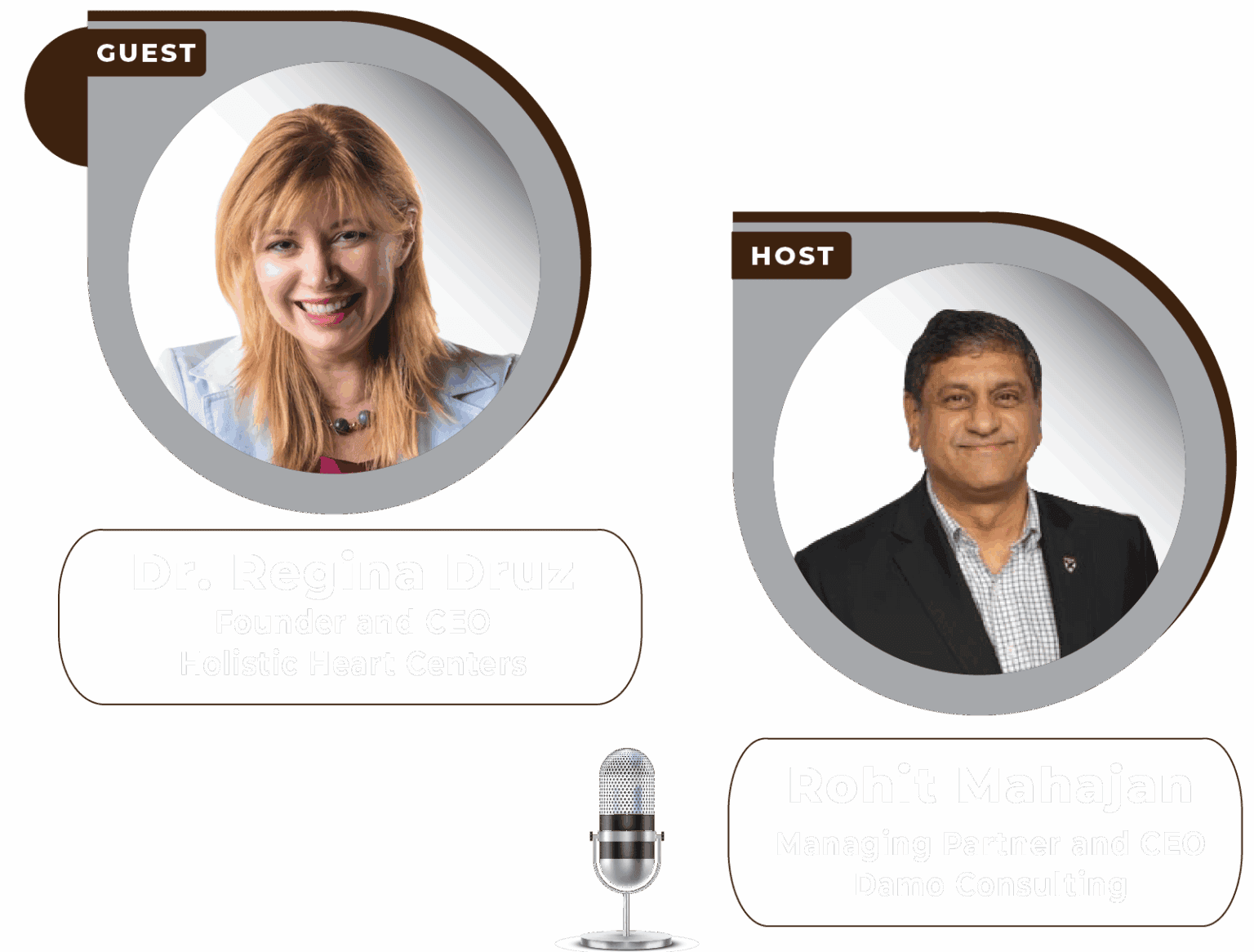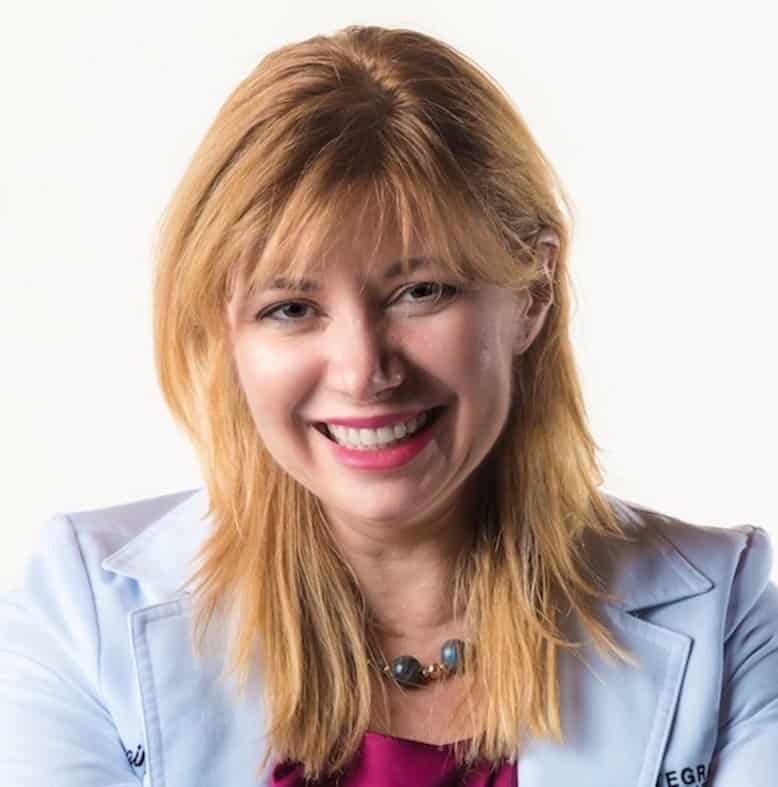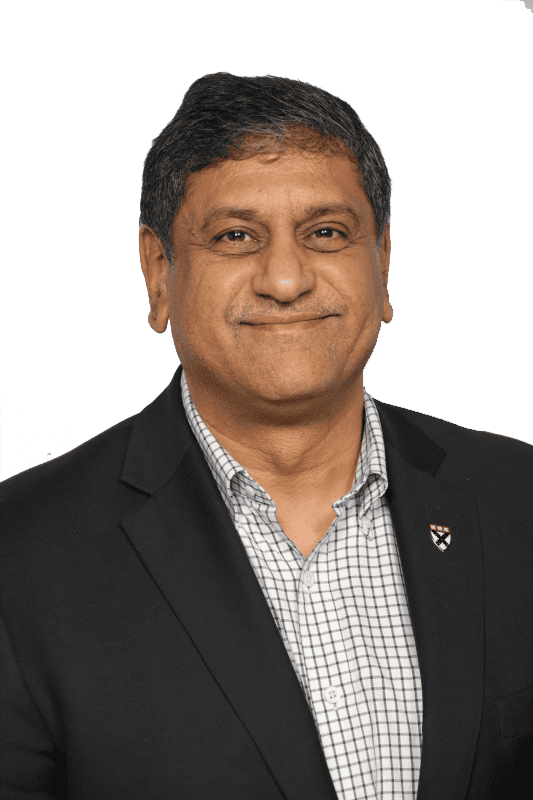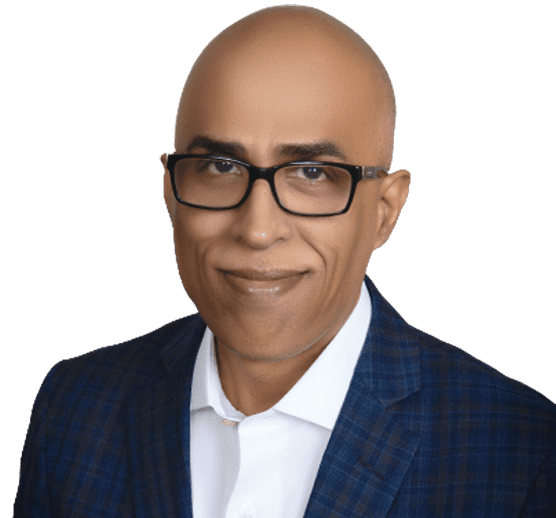Season 6: Episode #177
Podcast with Dr. Regina Druz, Founder and CEO, Holistic Heart Centers

Share
In this episode, Dr. Regina Druz, Founder and CEO at Holistic Heart Centers, shares her journey from conventional hospital-based cardiology to leading the charge in personalized precision medicine and longevity-focused care. She explains why optimizing health is the cornerstone of extending lifespan and how digital health innovations must deliver value for patients, clinicians, and caregivers—improving outcomes, reducing burnout, lowering costs, and meeting regulatory demands.
A pioneer in telemedicine, digital devices, and AI tools such as ambient scribes and large language models, Dr. Druz examines the opportunities and challenges of Agentic AI in transforming healthcare workflows. She envisions a near future where AI goes beyond administrative tasks to provide advanced clinical decision support—predicting and preventing conditions like Alzheimer’s and heart failure years before symptoms arise.
For Dr. Druz, the “N-of-1” approach—tailoring care to each individual’s unique biology and circumstances—will become the new standard, redefining population health through truly personalized care. Take a listen.
Video Podcast and Extracts
About Our Guest

Dr. Regina Druz is not just a cardiologist — she’s a trailblazer in the movement toward precision-based, longevity-focused medicine. As CEO and founder of Holistic Heart Centers™, she is redefining heart health through a cutting-edge fusion of integrative cardiology, functional medicine, and digital innovation.
With a medical degree from Cornell University, board certification in cardiology, and advanced training in functional medicine, Dr. Druz brings scientific depth and systems-thinking to every patient encounter. Her proprietary program, Fit in Your GENES®, personalizes care through genetic and metabolic profiling, offering clients a transformative roadmap to vitality and healthspan extension.
After earning a dual Executive MBA and Master of Health Policy and Research from Cornell, she went on to lead value-based cardiology transformation at the national level. Today, she applies that strategic vision to build scalable models of care that are personalized, proactive, and precision-driven.
Driven by data, powered by purpose, and rooted in compassion — Dr. Druz helps patients and healthcare systems move beyond risk management to true health optimization.
Recent Episodes
Q: Hi Regina. Welcome to The Big Unlock Podcast. I am Rohit Mahajan, Managing Partner and CEO at BigRio and Damo Consulting. It’s so nice to have you on the podcast, especially since you are a practicing physician. Would you like to introduce yourself to the audience?
Regina: Well, Rohit, thank you so much for having me, especially since I am a practicing physician. I’m not a technical founder or someone in the data world full-time.
For you listeners, I am Dr. Regina Druz. I’m a board-certified cardiologist since 2001. I’ve gone through all the traditional cardiology training and worked in hospital settings, academic settings, and private practice. Along the way, I went down the entrepreneurial route, which led me to personalized precision medicine, longevity medicine, and rethinking what cardiology should be. One of my colleagues calls it “comprehensive cardiology.” It’s about redefining what I can bring to patients and how they can benefit beyond traditional, expected care.
Q: That’s very cool, Regina, to know that you are now on the path of your entrepreneurial journey as well. So tell us, what attracted you to healthcare in the first place? How did it all start?
Regina: Good question. My parents are not physicians, but I grew up with amazing role models. My aunt and her daughter, my cousin, were the original power women, though the term didn’t exist then. Both were physicians—obstetrician-gynecologists—and were excellent at what they did. My aunt, after her education, was asked to go to an underdeveloped country to help build healthcare and improve maternal mortality. Many women at that time were dying in childbirth, and she brought in new practices that made a huge impact.
They were inspiring role models. Since I was young, I said, “I’m going to be like them. I’ll be a doctor, I’ll be strong, I’ll cure the world.” My father, an electronics engineer, pushed me toward technical fields, and I enjoyed science. But biology really grabbed my attention. The rest was conventional: medical school, residency, fellowship.
I didn’t end up a gynecologist, which disappointed my family a bit. They said, “Oh my goodness, you’re choosing to be a cardiologist?” But I said, “Women can do cardiology too.” Luckily, more women have entered cardiology over the past 20–30 years, and specialties once dominated by men are now more welcoming. Women are making their mark. That’s me in a nutshell.
Q: That’s a very cool journey, Regina. So you talked about something in your introduction which caught my attention around personalized medicine and longevity. So please tell us like what does it all mean and how’s it coming together?
Regina: That’s a great question, Rohit. Maybe I’ll take you back to some of my more traditional cardiology days. When I was working in a hospital setting, I was responsible for an area involved with cardiac imaging. We have various procedures to image the heart, understand how it functions, if the blood vessels are open, if the valves are doing okay, and if we can foresee the future and understand what’s going on. My particular area was nuclear stress tests. Patients typically had to exercise on a treadmill as part of a stress test. For those who couldn’t exercise, we used a chemical stress test, but the majority exercised on a treadmill. We would inject a little bit of radioactive material to see how blood flows into their heart and determine if their heart is healthy.
What came out of it is that as doctors, we were a bit biased. We would expect younger people to do better, and that older people would not do as well. But 20–30% of the time, we would get the opposite—an older person who did much better than expected, and a younger person who did very poorly. This started my journey into personalized medicine. I started to ask if there was a pattern—what are the older people doing to preserve this ability into older age, and what are the younger people doing, or not doing, that actually takes away from what we think they should be able to do, cardiac-wise and physically?
I started asking patients questions that weren’t part of our standard intake. Do you exercise at home? Do you garden? Do you travel? What do you like to do? What gives you purpose? I looked at other physicians who introduced this idea of “n of one,” of personalized medicine. There are reasons, systems biology, root causes driving health and longevity, and also driving disease. It’s not standardized; it’s not a population-based metric. It’s literally the N of one.
That piqued my curiosity, so I decided that the best way to address it was to take what I know in cardiology and bring it into a personalized medicine approach. The best fit for it was integrative and functional medicine, where we could expand our lens and look beyond just hard numbers—like cholesterol, blood pressure, and medications—and ask why levels are elevated, and what we can do lifestyle-wise to optimize health. Optimized health is a major contributor to longevity. Physical health, cardiovascular health, brain health, and systemic health are really the foundation of any longevity equation. You can’t talk about longevity if health isn’t optimal.
That was the beginning of going off the beaten path. My colleagues thought I was crazy because they could not understand it. They said, you have great credentials and roles. At that time, about ten years ago, there was no room in the institutional setting for this. There could have been some departments inclined toward integrative or complementary medicine, but nothing institutional. That meant going on my own, right as medicine was beginning to consolidate. People said I was insane and would do very poorly. I opened my first tiny practice with about three patients in an area saturated with cardiologists. Even back then. Today, it’s exponentially so. I’m here to tell you this works, and this was not only a huge benefit to my patients, but it was a benefit to me.
Q: That’s awesome, Regina. And I know you are very interested in all the new technologies coming our way. In any podcast these days, we have to touch upon AI. How do you look at AI and digital health from the lens of cardiology? What does it mean to you, and how do you see some use cases from a physician, patient, and caregiver perspective? How does it all play out in your world?
Regina: It’s a great question, Rohit. I was an early adopter, so back then there weren’t as many things available to us. Right now we have so much more. In any digital health domains, in cardiology or any specialty, you have to ask how they benefit a patient, and how they help doctors, patients, and nurses to do the right thing without burning out, saving on cost, and staying compliant with regulations.
I started with telemedicine. I was an early adopter, and since my practice was personalized, telemedicine is a great tool. It gives patients a lot of access, but it has a major deficiency: you’re not getting a physical exam. You can’t listen to a patient or do those things. I needed their blood pressure, electrocardiogram, and a couple of other measures to assess if they are okay. This led me to explore digital tools available—there are quite a few. For example, a company called AliveCor created a device you could clip onto an iPhone, and by putting two fingers on metallic plates, it would record a single-lead electrocardiogram. It wasn’t a full EKG, but it was the beginning.
Other companies like Omron and Withings came out with Bluetooth-enabled blood pressure cuffs, letting patients check their blood pressure and transmit the information to me. For the first time, with telemedicine adoption, I wasn’t blind anymore. When COVID came and in-person visits were canceled, I wasn’t stuck. I already had the telemedicine platform and some of these tools.
Now it’s even more diverse. I routinely use the tools from these companies. Now we can do a Bluetooth-enabled 12-lead electrocardiogram with AliveCor—no traditional machine needed, just a small remote controller with a button. Cardiac and vascular ultrasounds now have devices like Butterfly IQ, which has ultrasound on a chip that connects to a phone or iPad, providing diagnostic images affordably.
Digital devices first went to practitioners and are now available to patients. Patients use Apple Watch, Withings, Fitbits, and other trackers. Suddenly we have overwhelming streams of data. Now, AI has come into the picture. Patients are becoming “citizen patients”—they investigate themselves, upload their data into large language models, and get outputs. They have agency to do this, even if they can’t always tell whether the output is correct.
These data streams are becoming routine in medical practice. Places like Mayo Clinic use large data repositories and AI tools to analyze electrocardiograms and predict heart failure years before symptoms appear. This is a huge opportunity. We could work with high-risk individuals preventatively, sparing them clinical heart failure. Once someone has their first heart failure episode, five-year mortality is 50%. Imagine if we could be ahead of this curve.
We are evolving from curiosity to clinical implementation and, hopefully, to clinical competency—making this standard care, not just a nice-to-have. Regulatory bodies recognize the value of these devices. Medicare, for example, pays for remote care monitoring (RCM), usually reserved for higher-risk patients and accomplished through digital devices and AI interfaces. They allow us to identify what’s happening—a sort of third eye.
Q: That’s pretty deep usage of AI and digital devices in different ways, Regina. One other thing—I know you mentioned large language models. Another thing that’s become very popular is AI coding tools. We were just chatting before the podcast, and I have several physician friends experimenting with such tools. So tell us your experience. You mentioned an article too; tell us more about what you’re seeing in this space.
Regina: This is very interesting because when ChatGPT became a household name, I said, okay, let me give it a try. At the time, I was studying for my boards. Cardiology boards have different ways to maintain certification. One newer way is that every year you do a small cardiology knowledge exam. It was time for my exam, and I was studying using traditional stuff from the American College of Cardiology, but some explanations to questions left me wanting more. So I started putting those questions into ChatGPT, and it gave me deep, nice, long explanations that covered some of my blind spots. That was interesting. I think large language models, when they don’t hallucinate, are great educational tools. You can constrict them to look at specific journals or guidelines.
But the real breakthrough for me as a practicing clinician came from ambient AI scribes. They became indispensable in my practice. There are several companies; I personally use one called Heidi Health, a startup from Australia. Most people think ambient AI scribes just catch conversations and save time on notes, which is true, but there was something else—a positive externality. The structure of the AI scribe allowed me to generate versions of notes, including one I could send as a message to patients via patient portals. This summarized next steps clearly—what they need to do and how. Instead of reinventing this, after some tinkering, I generated a template I liked. This enhanced my patient care meaningfully by adding another touchpoint, another opportunity for engagement. It also helped me not have to remember everything but to clearly outline the next step.
In personalized medicine and longevity health optimization, this requires a lot of participation. It’s very different from traditional medicine where doctors just tell patients what to do and wait for them to come back. Here, it’s the opposite; you need to reach out regularly. The AI scribes gave me that ability to be efficient and effective and to “excite and delight” patients with better communication.
As a clinician entrepreneur, I am also experimenting with Agentic AI. Some experiences are helpful; some are questionable. One unsettling issue, raised by AI experts like the CEO of Tropic, is that AI is a black box. We lack full visibility into how it generates answers, especially with agent AI. I asked it for a simulation on a complex patient with cardiac and immune issues, including all parameters we know. The AI produced a great output with references and did not hallucinate. My initial hunch was correct, but I wanted to know how it built the case. In medicine, we use frameworks for diagnosis, workup, and prognosis—check and balances learned from real outcomes. That’s where AI’s black box presents challenges.
Whether it’s LLMs or chatbots or more complex agent functions, we are in uncharted waters. We will use them going forward, but we need more visibility into their processes for trust and safety.
Q: Of course. Regina, I think we hit on something during our pre-podcast discussion about the digital divide. You said people with high agency will propel ahead using such tools. Could you explain your thought process behind that?
Regina: Great question, Rahi. The digital divide often comes up with digital tools like wearables or telemedicine platforms. We have to ask whether certain patient groups will face barriers. Older patients may not be technologically savvy enough to navigate telemedicine or connect Bluetooth-enabled devices like blood pressure cuffs. They might struggle with mobile apps or synchronizing devices. Plus, healthcare privacy is heavily regulated.
Traditionally, the digital divide affects older patients, those with cognitive issues, non-English speakers, and those who can’t afford or access these tools. But I believe another digital divide is forming. Recently, I read a Wall Street Journal piece about AI tools that almost anyone can access at a free level. To truly benefit, users must be “high-agency” individuals—able to instruct the tool, understand its limitations, refine outputs, and keep moving forward.
I see this with my patients. Those with high agency get more information, more touchpoints, and a very different experience managing their health compared to those less inclined to use these tools. Physicians sometimes reinforce this divide. One colleague, Dr. Kim Williams, former ACC president and lifestyle medicine champion, uses ChatGPT as part of his team. He inputs patient scenarios—not for medical advice but for cultural context—to help patients transition to healthier diets without overwhelming them.
Q: That’s awesome. As we close, Regina, looking into your crystal ball over the next 3–5 years, what exciting things do you see coming our way?
Regina: It’s an interesting one because I ask it to myself very often. In the physician community, there are a lot of voices who say AI is going to replace doctors. And then, from the tech world, there are predictions like no more radiologists.
Of course, there are other voices that are more introspective and say no, AI is not going to replace doctors. To me, it’s very clear that we are going to see in the next five years a rapid emergence of agentic AI in all verticals of healthcare. It’s going to take care of mundane tasks like pre-authorizations, appointment scheduling, and supply chain management.
Then it’s going to really make its mark in staffing decision making, especially when calibration is needed between demand and supply. And it’s already doing it in clinical decision support. For example, there is a company called Aidoc that allows radiologists to identify life-threatening pathology on brain scans that potentially they may have missed. There are AI-enabled mammography tools that can predict occurrence of breast cancer before it even happens.
There is also an investigational AI tool that allows clinicians to predict the onset of Alzheimer’s dementia before any cognitive decline. As a personalized medicine and longevity doctor, this is where I see the biggest impact. Transitioning into clinical decision support, I predict it will make the “N of one” personalized medicine a standard type of medicine. Eventually, we will abandon our focus on large populations because AI will enable us to address population health differently. We’ll be able to leverage small data, that N of one, to build much more enriched phenotypes. Populations as we know them for investigations and healthcare will be redefined through AI, and that will be a huge impact.
Q: That’s awesome. Thank you, Regina. This has been a very interesting conversation. Really appreciate it. Any other last comments?
Regina: Maybe just a quick note to anyone listening who might be a physician, nurse, nurse practitioner, or anyone in healthcare with a medical affiliation. If you’re thinking, should I be doing it, should I not, should I jump into this entrepreneurial route and see where it takes me? There are no guarantees, but if you are one of those people, the best time was 30 years ago. The second-best time is now.
————-
Subscribe to our podcast series at www.thebigunlock.com and write us at [email protected]
Disclaimer: This Q&A has been derived from the podcast transcript and has been edited for readability and clarity.
About the host
Paddy is the co-author of Healthcare Digital Transformation – How Consumerism, Technology and Pandemic are Accelerating the Future (Taylor & Francis, Aug 2020), along with Edward W. Marx. Paddy is also the author of the best-selling book The Big Unlock – Harnessing Data and Growing Digital Health Businesses in a Value-based Care Era (Archway Publishing, 2017). He is the host of the highly subscribed The Big Unlock podcast on digital transformation in healthcare featuring C-level executives from the healthcare and technology sectors. He is widely published and has a by-lined column in CIO Magazine and other respected industry publications.

Rohit Mahajan is an entrepreneur and a leader in the information technology and software industry. His focus lies in the field of artificial intelligence and digital transformation. He has also written a book on Quantum Care, A Deep Dive into AI for Health Delivery and Research that has been published and has been trending #1 in several categories on Amazon.
Rohit is skilled in business and IT strategy, M&A, Sales & Marketing and Global Delivery. He holds a bachelor’s degree in Electronics and Communications Engineering, is a Wharton School Fellow and a graduate from the Harvard Business School.
Rohit is the CEO of Damo, Managing Partner and CEO of BigRio, the President at Citadel Discovery, Advisor at CarTwin, Managing Partner at C2R Tech, and Founder at BetterLungs. He has previously also worked with IBM and Wipro. He completed his executive education programs in AI in Business and Healthcare from MIT Sloan, MIT CSAIL and Harvard School of Public Health. He has completed the Global Healthcare Leaders Program from Harvard Medical School.

Paddy was the co-author of Healthcare Digital Transformation – How Consumerism, Technology and Pandemic are Accelerating the Future (Taylor & Francis, Aug 2020), along with Edward W. Marx. Paddy was also the author of the best-selling book The Big Unlock – Harnessing Data and Growing Digital Health Businesses in a Value-based Care Era (Archway Publishing, 2017). He was the host of the highly subscribed The Big Unlock podcast on digital transformation in healthcare featuring C-level executives from the healthcare and technology sectors. He was widely published and had a by-lined column in CIO Magazine and other respected industry publications.
Stay informed on the latest in digital health innovation and digital transformation